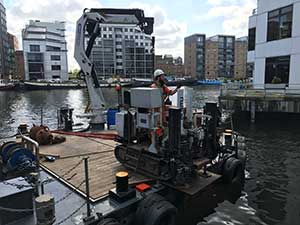Fellows surveys Millwall Dock to ensure safe pontoon project

During WWII an estimated 24,000 tons of High Explosive (HE) bombs were dropped on London in 85 major raids that occurred between 1939 and 1945. Starting in September 1940 London was attacked by the Luftwaffe on 57 consecutive nights. As many as 300 bombers attacked numerous targets across the city during the raids dropping various sized HE bombs. The most commonly used bombs were the SC50 (100lbs) and SC250 (500lbs). The attacks finally subsided in May 1941. This period of concentrated bombing became known as the ‘Blitz’. The bombing density for The Isle of Dogs between 1939-1945 was 300-399 bombs per 1,000 acres.
Recent UXB discoveries such as the large 1000lb (SC500) bomb located in King George V dock adjacent to London City Airport in February 2018 have highlighted the risk posed by UXO and the need to have appropriate control measures in place. Any development project in areas with a known UXO contamination risk could encounter UXO which has either been abandoned or failed to function as intended and has remained buried in the ground or seabed.
For the Millwall Docks project, Fellows used a CPT mini rig to test five pile positions, investigating to a depth of three metres into the dock bed (8-9m water column). The results of the survey showed there were no UXB’s within an acceptable radius of each position and the intrusive phase of the project has been cleared to commence now that the risk of encountering UXO has been lowered to as low as reasonably practicable (ALARP).
